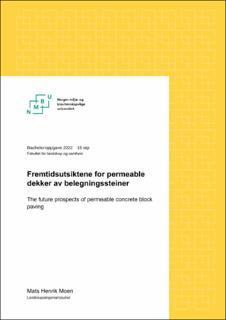| dc.contributor.advisor | Degvold, Frode | |
| dc.contributor.advisor | Håbjørg, Kjersti Vallevik | |
| dc.contributor.author | Moen, Mats Henrik | |
| dc.coverage.spatial | Norway | en_US |
| dc.date.accessioned | 2022-08-17T12:13:21Z | |
| dc.date.available | 2022-08-17T12:13:21Z | |
| dc.date.issued | 2022 | |
| dc.identifier.uri | https://hdl.handle.net/11250/3012356 | |
| dc.description.abstract | Tittelen til oppgaven er: «Fremtidsutsiktene for permeable dekker av belegningssteiner». Det er knyttet en del utfordringer opp til bruk av permeable dekker av belegningsstein. Samtidig er det behov for å imøtekomme dagens og fremtidens strenge krav til overvannshåndtering. Hovedproblemstillingen i oppgaven er derfor: «Har belegningssteiner i permeable dekker en fremtid i norske grøntanlegg?»
Metodene som er brukt i oppgaven er spørreundersøkelse, litteratursøk og intervju. Spørreundersøkelsen hadde som formål å innhente informasjon om hvilke utfordringer grøntanleggsbransjen har til permeable dekker av belegningsstein. Undersøkelsen fikk 16 svar, og kom frem til at de seks største utfordringene bransjen ser ved bruk av et slikt dekke er; permeabilitet over tid, visuelle egenskaper, miljøhensyn, universell utforming, drift og vedlikehold samt dokumentasjon. For å samle informasjon rundt disse utfordringene, ble det gjennomført litteratursøk og intervju med relevante kontakter.
Oppgaven konkluderer med at det er en fremtid for permeable dekker av belegningsstein, men det stilles tre forutsetninger for at denne løsningen skal være et godt valg: 1. Det må utvikles en forsterket gjensidig kommunikasjon mellom grøntanleggsbransjen og produsentene av belegningsstein. 2. Prosjekteringen av utførelsen er nøye gjennomtenkt. 3. Dekket vedlikeholdes regelmessig etter en egen drift- og vedlikeholdsplan. | en_US |
| dc.description.abstract | The title of this thesis is: “The future prospects of permeable concrete block paving”. There are several challenges associated with the use of permeable concrete block paving. At the same time, it is necessary to meet todays and the future strict requirements for surface water management. The main research significance in this thesis is therefore: “Does the future of Norwegian green spaces include permeable concrete block paving?”
The chosen methods used in this thesis are a survey, search of literature and interviews. The purpose of the survey was to obtain information on the challenges the industry of green spacing faces in using permeable concrete block paving. The survey received 16 responses, and concluded that the six biggest challenges the industry sees in using such a paving are; permeability over time, visual characteristics, environmental considerations, universal design, maintenance and documentation. To gather information about these challenges, a literature search and interviews with relevant contacts were conducted.
The thesis concludes that there is a future for permeable concrete block paving, but three prerequisites are set for this solution to be a good choice: 1. Reinforced mutual communication must be developed between the industry of green spacing and the producers of paving stones. 2. Thorough planning of the execution is crucial. 3. The maintenance of the paving is regularly maintained according to an operation and maintenance plan developed for the specific paving. | en_US |
| dc.language.iso | nob | en_US |
| dc.publisher | Norwegian University of Life Sciences, Ås | en_US |
| dc.rights | Attribution-NonCommercial-NoDerivatives 4.0 Internasjonal | * |
| dc.rights.uri | http://creativecommons.org/licenses/by-nc-nd/4.0/deed.no | * |
| dc.title | Fremtidsutsiktene for permeable dekker av belegningssteiner | en_US |
| dc.title.alternative | The future prospects of permeable concrete block paving | en_US |
| dc.type | Bachelor thesis | en_US |
| dc.description.localcode | B-LI | en_US |

